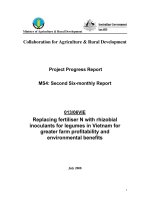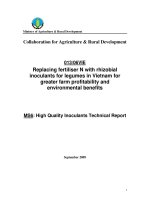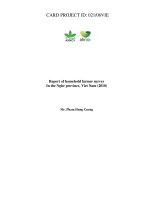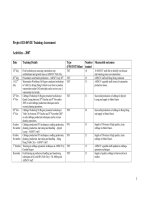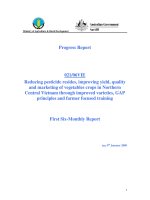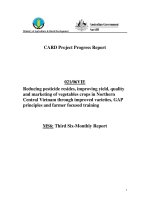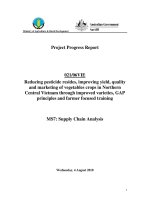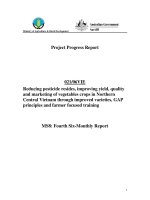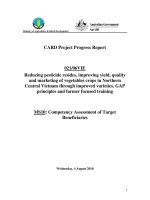Báo cáo khoa học nông nghiệp " Achievements and lesson learnt from implementation of the project "Sustainable community-based forest development and management in some high-poverty areas in Bac Kan Province" " pot
Bạn đang xem bản rút gọn của tài liệu. Xem và tải ngay bản đầy đủ của tài liệu tại đây (35.63 KB, 10 trang )
1
Achievements and lesson learnt from implementation of the project
"Sustainable community-based forest development and management in some
high-poverty areas in Bac Kan Province"
Khongsak Pinyopusarerk, Tran Van Dien
Implementing Agencies: CSIRO - Australia; Thai Nguyen University of Agriculture and
Forestry
1. INTRODUCTION
Ethnic minority communities in the remote mountainous northern provinces of Vietnam are
among the poorest in the country, with limited access to agricultural land, health facilities,
markets and infrastructure. Van Minh and Lang San communes of Na Ri district in Bac Kan
province have poverty rates of 63-68% [1]. Forested land comprises 84% and 90%
respectively of the total land area and is of paramount importance for community livelihoods,
including collection of firewood, harvesting food and herbal medicinal plants. However, lack
of access to utilise forest land and unequal allocation of forest areas to the poorer families
have led to serious poverty. Management of the forest has also exacerbated the situation
through many problems: (i) low productivity due to forest degradation after excessive use and
little investment; (ii) perceptions of forests as common lands with free access, with unclear
boundaries and poorly defined ownership obligations; (iii) few incentives to reinvest in the
forest (no security) and reluctance to take direct responsibility for the land; (iv) poor
awareness of user rights, forest laws and regulations, and rights of participation in official
processes such as forest land allocation; and (v) very limited support from government
agencies in approaches to effectively use the forest land and earn income [2].
The Land Law which came into effect on 1
st
July 2004 allows communities (villages) to
receive land and forest land [3]. However, there is no mechanism to realise this option. This
project will therefore develop mechanisms under Community Forestry Management including
participatory land use planning and land allocation to facilitate land distribution and address
the sustainable management of the forest.
The project Goal is
Sustainable improvement in livelihood security of disadvantaged forest-dependent people in
northern mountainous areas, through empowerment of access to forest and forest land,
influence over forest land management, conservation of the natural resources and
development of relevant skills.
2
2. METHODOLOGY
Four villages: Na Muc and Khuoi Lieng in Van Minh commune and To Dooc and Ban Sang
in Lang San commune in Na Ri district - Bac Kan province which have community forest
lands were selected to be the research site for the project. The community forest lands are
target area for project interventions, that includes land use planning, forest land allocation,
forest enrichment, nursery, plantation and agro-forestry development. The quality of
community forest was assessed through forest survey to identify the productivity as well as
biodiversity. The social economic condition of local community and the dependency of
livelihood of local community on the forest were identified by socio-economic survey. The
data relating to land use planning, forest land allocation, forest enrichment, nursery, plantation
and agro-forestry models were also recorded in the field based the samples. The processes of
land allocation, management of community forest development fund, implementation of
community forest management plan were also recorded. The outcomes and impacts of training
activities were assessed at the phase out period. Cost benefit for each community forest
management models was analyzed to evaluate the effectiveness of each activity.
3. RESULTS AND DISCUSSIONS
3.1. Allocation of community forest lands to communities
Allocation of communication forest lands to communities was firstly implemented in Bac Kan
province. The allocation process met many difficulties both paper works as well as field
works. The most difficult work is solving conflicts on the border of community forest. Before
community forest was considered as common property which was exploited and used by local
people from many villages. So it is extremely difficult to allocate the community forest to
only 01 village. However, by participatory approach in solving the problems, the consensus
have been made among neighbor villages. Therefore, the borders of community forest in four
villages were defined and the field maps were also constructed. The formal processes of
community forest land allocation have been completed for four project villages with “Red
Book” for long-term use rights (Table 1).
Table 1: Results of community forest land allocation in four target villages
# Villages Community forest
land allocated (ha)
% of Community forest
land allocated
1 Ban Sang 154.3 100
2 To Dooc 45.1 100
3 Na Muc 118.3 100
4 Khuoi Lieng 121.1 100
3
This would give local communities the confidence to contribute and invest labor and other
inputs to the protection and development of community forest lands for overall local benefit;
Lessons learnt:
- The border of community forest have to clear defined by participatory approach before
processing the paper works
- Strong cooperation between district and commune authorities, especially between
Forest Protection Department and Department of Natural Resources and Environment
in conducting the filed works as well as the paper work play a key role for the success
of the community forest land allocation.
- Certain budget is needed for field work of the commune and district cadastral staff.
3.2. Establishment community forest management (CFM) plan
After receiving the official rights of using the CF lands, the CFM plan have been established
in each village. The CFM within each village consists of two elements: (1) regulations which
provide a legal framework for village members to implement the CFM plan at the village level,
and (2) a CFM plan which describes and lists the activities that will be undertaken. Both the
regulations and plans are a result of separate village meetings and discussion. Therefore while
the general scope is maintained across the four villages, the contents differ depending on the
land use preferences and enforcement level of each village.
General contents of CFM regulations
- Rights and responsibilities of all community members in forest protection and
development
- Rules to protect forests and mobilize human resources to protect and develop forests
- Logging, buy and sell, timber and non-timber transport
- Grazing animals in the community forest
- Prevention of forest fire
- Checking and preventing outsiders from shifting cultivation, illegal logging or hunting,
and illegal buying, selling and transporting timber/non-timber/animals within the
village.
- Cooperation among community members in forest protection/development, production
services and sale of products.
- Collaboration with other villages to protect and effectively develop the forests
- Regulations on penalty for infringement of the forest protection rules
- Regulations on sharing benefits among community members
- The regulations should be presented to all community members and submit for
approval by Commune People's Committee.
4
General contents of CMF Plan
- New plantation plan such as what kinds of species? how large the area?, where? when?
how much of labor costs? how many seedlings? sources of seedlings?
- Nursery plan, seedling production
- Maintenance and protection
- Harvesting plans
- Human resource (labor input) plan
- Other activities such as agro-forestry
Lesson learnt in establishment of CFM plan:
- It is necessary to modify the Guidelines of MARD on Community Forest Management
(Figure 1) which issued on November 27th 2006 (Decision 106/2006/BNN-PTNT) for
more simple and practical in local condition [4].
- Participatory approach to develop the CFM is crucial factor for establishment an
feasible and practical CFM plan.
- Staff of district Forest Protection Department and commune extension workers are
main technical sources to provide supports for community in developing the CFM plan.
3.3. Implementation of CFM plan
3.3.1. The involvement of community members in CFM
Within each village, a CFM board of 5 persons has been elected by open votes to oversee
overall implementation. All four villages have places a strong emphasis on plantation forest
for protection of watershed areas and for commercial wood production. During meetings and
discussion which were attended by at least one member of every household, all household
representatives have expressed their commitment to contribute labor inputs in the
implementation of the plan. Another common agreement across all four villages is an attempt
to reduce and stop shifting cultivation and free grazing in community forest areas. Number of
households involved in CFM is presented in Table 2.
Table 2: Current involvement of community members participating CFM [5]
Villages Total village
households involved
with CFM
Total males aged >15
involved in CFM
Total females aged >15
involved in CFM
Quantity % Quantity % Quantity %
Na Muc 23 100 54 100 52 100
Khuoi Lieng 35 100 81 100 72 100
To Dooc 19 73 30 46.7 32 46.3
Ban Sang 69 100 157 100 145 100
5
3.3.2. Capacity building for local people
Based on the training needs of local community, various trainings were conducted as
presented in the Table 3. Most of the trainings were conducted as Farmer Field School (FFS)
approach. The trainings help all local community members to be aware of laws on forest
protection and development and be more knowledgeable and skillful in technical issues
relating to forest management.
Table 3: Training courses conducted in the project area [6]
# Training topics Number of direct
beneficiaries
1 Land-use planning and land allocation 26
2 Planning and implementation of community forest management 25
3 Village nursery propagation 125
4 Plantation forest development 82
5 Law on forest protection and development 80
6 Agro-forestry model for income generation 64
7 Sustainable harvest of non-timber forest products 82
3.3.2. Establishment of village-based nurseries
The radical constraint of forest development in both community forest lands and household
allocated lands is lacking of forest seedlings. Some projects have provided the seedlings to
area, but it wasn't successful. The survival rate was very low due to the long distant
transportation. Therefore, the establishment of village nursery garden to produce the seedling
at plantation site is not only to ensure the high survival rate of seedlings, but also create a
more income generation for local people. The project facilitated the establishment of village-
based community nurseries for raising quality tree seedlings for sale or distribution to land
owners. Key inputs provided by the project included training in nursery management and
methods and provision of access to quality genetic seed sources of Acacia mangium (from
CSIRO and RCFTI) and Manglietia . During three years of project implementation, a huge
number of forest seedlings have been produced for replantation of both community forest
lands and household allocated lands as presented in the Table 4.
6
Table 4: Number of seedlings produced annually in four target villages
Villages Manglietia conifera Acacia hybrid Total
Na Muc 30,000 40,000 70,000
Khuoi Lieng 20,000 30,000 50,000
To Dooc 20,000 30,000 50,000
Ban Sang 30,000 40,000 70,000
Table 5 reveals that a community requires at least 5 million VND to establish a nursery and
more than 16.5 million VND a year for operating expenses. The cost for a seedling is only
309 VND, while the market price is 700 - 1000 VND.
Table 5: Costs for a village-based nursery producing 70,000 seedlings/year [7]
Cost items Cost (VND)
Construction of nursery garden (capital cost) 5,120,000
Operating cost 16,498,000
TOTAL COST 21,618,000
Cost per seedling 309
3.3.3. Agro-forestry models in community forest lands
The design of the agro-forestry model takes into account the need for income generation for
communities. Expanding market opportunities exist for planted trees of a number of species
reflecting the transition from dependency on a natural forest to a planted resource. By
selecting appropriate species well adapted to the local environment, which are fast growing
and meet a market need, communities can benefit financially from tree planting projects either
on community land or other land surplus to agricultural requirement. Crops on the other hand
will provide opportunities for added food security with surplus crops providing additional
income. The areas for the agro-forestry model trials are about one hectare each village.
The selection of species is based on the key species recommended in the land use planning
surveys which are considered to have potential as either commercial species or for use in alley
cropping systems. For timber production, Acacia hybrid (Keo lai), Manglietia conifera (Mo)
and Melia azedarach (Xoan) are preferred by villagers, and these are the tree species for this
model. In addition, one fast-growing, multi purpose species, Cassia (cot khi) has been
selected for planting on the contours for soil erosion control. Agricultural crops planted
between tree rows was chosen by villagers based on local experience. Hybrid corn, improved
7
soybean, taro and cassava have been selected for growing in agro-forestry models. Table 6
shows the yields of the agriculture crops in the agro-forestry models in the target villages.
Table 6: Agricultural crop yields in 2008 and 2009 in the four project villages
Unit: kg/ha
Years Crops Na Muc Khuoi Lieng To Dooc Ban Sang
2008 Soybean 400 630 650 700
Taro - 300 - -
Cassava - 5000 - -
2009 Maize 4500 2000 2200 2000
Soybean 1400 - - -
Table 7: Plant height of forest tree in agro-forestry models after two years of planting
Unit: m
Species Na Muc Khuoi Lieng To Dooc Bang Sang
Manglietia conifera 2.0-2.5 2.0-2.5 1.5-2.0 1.5-2.0
Acacia hybrid 2.5-3.0 2.5-3.0 2.0-2.5 2.0-2.5
Melia azedarach 2.0-2.5 2.0-2.5 - -
3.3.4. Community forest development funds (CFDF)
Community Forest Development Fund is developed by the community through initial seed
money of CARD project. The main purpose of this fund is for forest development activities in
community forest areas in the village. Activities related to community forest development can
use this fund following the community's regulations. This fund will be maintained and grown
for long-term purpose. The fund is managed by Community Forest Board. Financial issue
should be reported to village meetings to ensure transparency.
Sources for CFDF
a) Funding from CARD project:
- CARD project contributes 1,000 AUD (13 million VND) as "seed money" to establish
the fund.
- Household who receive seedlings from the village nursery to plant on their own land
must contribute 50 VND per seedling to the fund (following regulations of nursery
management).
8
b) Income from timber and non-timber forest products from the community forest area:
- Contribute 20% of total income from non-timber forest product harvest such as
mushroom, fruits, and medicinal plants to the fund.
- Households within the village community are permitted to use timber from the
community forest areas to build their houses; they have to contribute 20% of the total
value to the fund.
c) Interest from loan
- The fund can be used for loan for agricultural and forestry production with low interest
of 0.6% per month based on demand of household members of the community forest.
d) Penalty from illegal actions following CFM regulation
- All penalty from illegal actions following the CFM regulations will put into the fund.
Management of CFDF
- CFM Board have a responsibility to manage the CFDF.
- Use of the fund to follow government's financial regulations (receipts, reports are
required).
- Accountant and head of the Community Forest Management Board has to report to
Commune People’s Committee on financial issues
Status of community forest development funds after two years of implementation (Jan, 2008 -
Jan, 2010) is presented in Table 8.
Table 8. Status of community forest development funds in four villages
Unit: Thousands. VND
Indicators Khuoi Lieng Na Muc To Dooc Ban Sang
Principal funds 13,000 13,000 13,000 13,000
Fund growth 6,160 7,068 10,000 3,188
Loans 14,650 10,300 21,000 7,500
Expenditure for CFM 1,465 127 850 594
Outstanding balance 3,195 7,784 2,735 9,968
The figure in Table 8 indicates that CFDF is well managed by local community. The fund size
of all four villages have been increased significantly. The poor households in the community
can access to CFDF as microfinance sources for forest development.
9
Lessons learnt from implementation of CFM plan
- Capacity building for local people on the rights to access to the community forest lands,
the rights to harvest and the responsibility to protect the community forest is considered
as the most important activity for the success of the implementation of CFM.
- Control free grazing in Bac Kan is a crucial factor for the success of the agro-forestry
models and replantation in community forest lands
- Clear demarcation of the community forest can avoid the conflicts between villages in
harvesting the forest products in the community forest.
3.4. The impacts/changes of due to implementation CFM plan
The survey to identify the impacts and the changes due to implementation of CFM plan on the
communities of four villages was conducted in March 2010. Results of the survey shows that
implementation of CFM plan has positive impacts on communities in term of livelihood
improvement, environment protection and forest quality (Table 9). 57-100% members of
communities agreed that implementation of CFM plan decreased number of illegal cases of
forest exploitation or violence. 59-100% members of communities responded that community
forest is well protected so it has been enriched. Therefore it creates a better environment such
as having water through a year, less natural disasters happen in local areas. In addition, the
implementation of CFM plan creates the equality and solidarity in the communities.
Table 09. Impacts and changes due to application of CFM plan [5]
Percentage of local people agreed (%) Indicators
Na Muc Khuoi Lieng To Dooc Ban Sang
Decreased illegal forest
exploitation
100 94.1 81.8 86.4
Enriched forest 81 100 90.9 89.4
Increased income 19 32.4 27.3 18.2
Equality of the community 33.3 44.1 45.5 31.8
Solidarity in community 76.2 61.8 54.5 39.4
Keep water 57.1 73.5 36.4 48.5
Protected environment 85.7 97.1 90.9 68.2
4. Conclusions:
- The allocation of community forest lands can only be implemented with the active
participation of local community and local authorities in solving the border conflicts,
field mapping and paper works
10
- The implementation of Guidelines of MARD on Community Forest Management
(Figure 1) which issued on November 27th 2006 (Decision 106/2006/BNN-PTNT)
should be flexible for more practical and adapted with in local socioeconomic and
culture conditions
- Capacity building for local people on the rights to access to the community forest lands,
the rights to harvest and the responsibility to protect the community forest is considered
as the most important activity for the success of the implementation of CFM.
- Community Forest Development Fund play an important role to promote the
participation of local communities to community forest management.
- The implementation of CFM plan has positive impacts on communities in term of
livelihood improvement, environment protection and forest quality: decreased number of
illegal cases of forest exploitation, community forest is well protected and enriched. In
addition, the implementation of CFM plan creates the equality and solidarity in the
communities.
REFFERENCES
1- People's Committee of Van Minh and Lang San (2006); Annual report of socioeconomic
2- Thai Nguyen University of Agriculture and Forestry (2007) Report of forest survey in Van
Minh and Lang San - Na Ri district - Bac Kan.
3- Vietnam Government (2004), Decision 181/2004/ND-CP;
4- Ministry of Agriculture and Rural Development (2006) Decision 106/2006/QD-BNN
5- Thai Nguyen University of Agriculture and Forestry (2010) Report of final baseline survey
in 4 CARD project villages.
6- CARD 017-06VIE (2009) Milestone 11 report
7-CARD017-06VIE (2009) Benefit-cost analysis report
